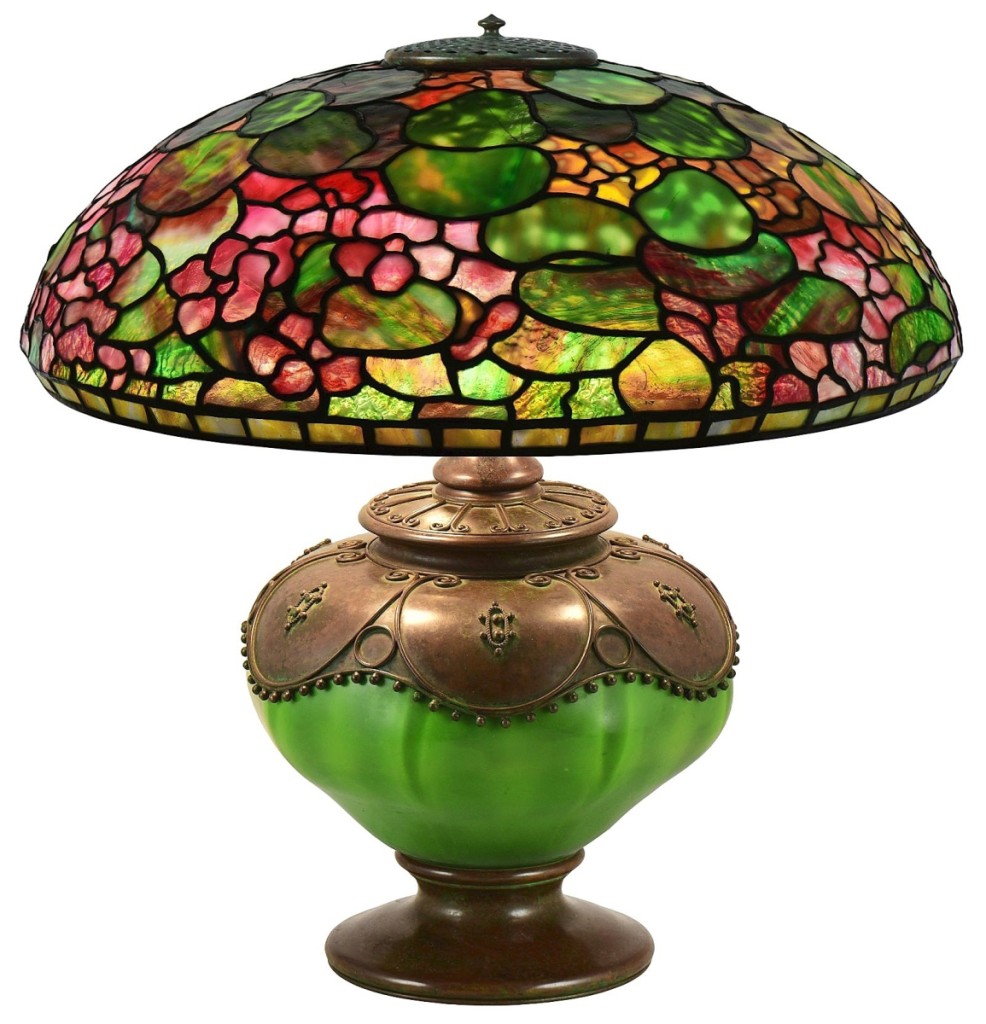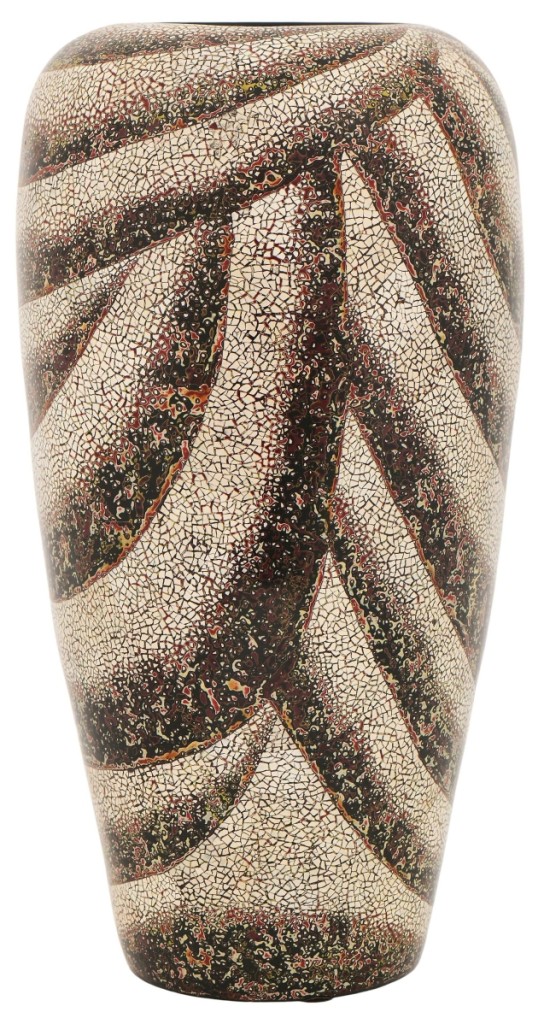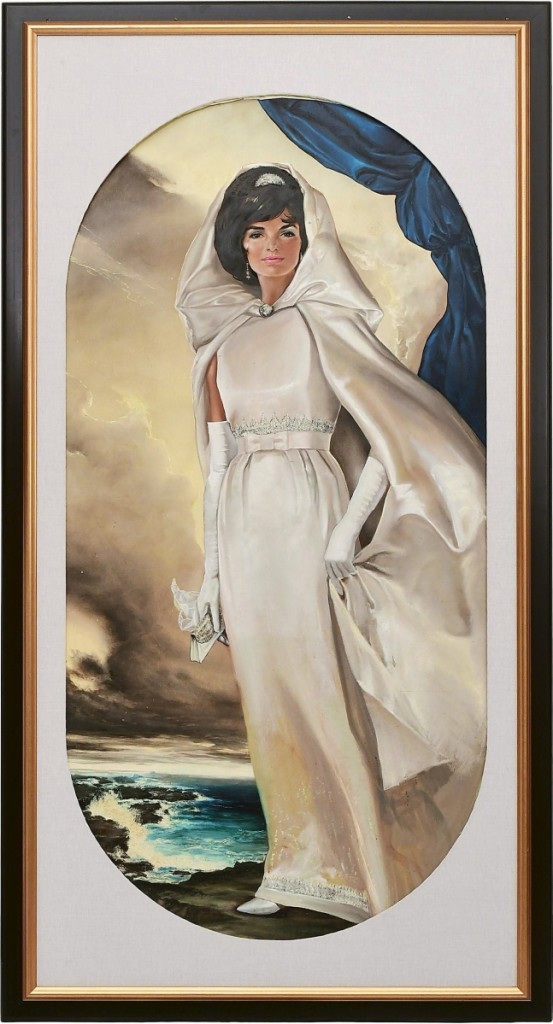Thomas Webb and Sons Art Glass Decorating Motifs Used

The star of the Tiffany tabular array lamp offerings, bringing $109,375, was a circa 1905 Nasturtium example. Information technology was signed twice on the shade, and the oil canister base was also signed "Tiffany Studios, New York, 28644."
Review by Rick Russack, Photos Courtesy Fontaine's Auction Gallery
PITTSFIELD, MASS. – Fontaine'due south Auction Gallery is known for selling Belle Epoch decorative arts and that'south what crossed the block at its February 5 auction. If you searched his sale for Tiffany, you lot would take found 90 items, mostly leaded lamps and Favrile drinking glass. Simply there was more: Pairpoint and Handel lamps, French and other art drinking glass, argent, furniture designed for the palatial homes of the period, paintings, bronzes, French bisque dolls, silverish, George Ohr pottery, to name just some. Net bidding was available, and phone and absentee bids were processed. Catalog descriptions were thorough and included condition statements, along with an invitation to call if more information was desired. The 499-lot sale grossed $2,150,000.
Equally expected, things named Tiffany were a main attraction and led the twenty-four hours. Four of the five highest priced items in the auction were Tiffany lamps. A Curtain Borders flooring lamp with a 25-inch shade, signed Tiffany Studios on the shade and base, brought the highest cost of the auction, $181,250, well higher up the judge, undoubtedly helped past its status. The catalog stated "Nosotros seldom telephone call anything in splendid condition, just nosotros tin can't find anything incorrect with this lamp. In that location are no heat cracks in the shade. The cap and sockets are original. In that location is no excess patina wear on the base. This is the all-time case of one of these lamps that nosotros have seen."
The 2d highest price of the sale, $115,625, was earned by a Byzantine floor lamp with a 26-inch shade signed Tiffany Studios, on a reproduction base. Leading the table lamps, bringing $109,375, was a circa 1905 Nasturtium case, signed twice on the shade, on an oil cannister base of operations signed "Tiffany Studios, New York, 28644" with the Tiffany Drinking glass & Decorating Company monogram. Pocket-sized defects to the shade were noted. More than quadrupling its approximate was a Tiffany manner Cobweb table lamp, which realized $24,375.
The wide selection of Tiffany Favrile glass items did well, and several exceeded their estimates. A Pulled Feather Favrile vase signed "LCT," inset into a fully marked bronze base sold for $5,000, four times the estimate. A signed bloom form vase earned $v,312, and another earned $four,375. A 14-inch dial basin and stand finished at $3,750, while a Tiffany Studios intaglio carved Favrile glass pitcher and tumbler reached $2,375, well higher up the estimate. Both the 8-inch bullpen and tumbler were carved with the grapevine pattern.

Jean Dunand worked in a variety of materials, including lacquer. Around 1925, he began to experiment with adding minute pieces of eggshell into his designs, a Japanese technique known as coquille d'oeuf. The procedure was virtually unknown in this country, but Dunand's Art Deco designs rapidly became popular, and this vase earned $15,625.
Selling beneath the guess was a modest, elaborately framed watercolor past Louis Comfort Tiffany, depicting an Arabian street scene, which brought $3,625. Tiffany started his career as a painter, initially self-taught but later on studied with George Inness in 1866. It was in 1875 that his involvement in glass developed and he initially worked at several glasshouses in Brooklyn. In the late 1870s, he, along with others, opened a design studio. The business took off after 1881 when he did the interior design work for the Mark Twain house in Hartford; the post-obit year he redecorated several rooms in the White House for President Chester Allen Arthur. (About of his piece of work in the White House was removed by President Teddy Roosevelt.) In 1885, he decided to concentrate on drinking glass, and the balance, every bit they say, is history.
Other fine art drinking glass also did well, as did pottery. In that location were five pieces of pottery, all signed, by George Ohr, who chosen himself the "The Mad Potter of Biloxi." Bidders were waiting for a small, crumpled ruddy vase that sold for $26,250. A dark bowl, 9 inches broad, with a light-green crumpled summit edge, brought $9,063 and the remaining pieces also did quite well. Unappreciated in his day, Ohr's work is now in several museums including the Smithsonian and Metropolitan Museum of Art.
There was ane piece of Newcomb College pottery: a 10-inch vase that was decorated with a blue/greenish floral pattern and sold for $7,813. A circa 1925 Coquille D'Oeuf vase was attributed to Jean Dunand, a Swiss/French artist who worked in various mediums, including lacquer. Effectually 1925, he began to experiment with adding minute pieces of eggshell into his designs, a Japanese technique known as coquille d'oeuf. The process was virtually unknown in the west at the time, and his work, in the Art-Deco manner, was rapidly accepted. The vase realized $fifteen,625.
A large Thomas Webb & Sons cutting crystal punch bowl, from the tardily Nineteenth Century, brought $7,188. It was signed "Due west. Fritsche" for William Fritsche, who was i of Webb's finest engravers.
The sale included more than 30 pieces of French cameo glass by Galle, Daum, Legras and other makers. A Hyacinth pattern diddled-out cameo vase by Emile Galle reached $5,625 and a colorful enameled cameo glass vase with floral designs by Daum Nancy, sold for $4,063. An unusual Arsall lamp with a cameo glass shade depicting elephants and jungle foliage, on a bronze base with a lion, went out for $iii,750.

John F. Kennedy commissioned this full-length portrait of Jackie from Ralph Wolfe Cowan (b 1931) and it sold for $33,750. The 98-by-52-inch portrait was unsigned but includes a letter of dedication to the previous owner.
Fontaine's sales often include massive, heavily carved pieces of piece of furniture suitable for the belatedly Nineteenth Century mansions of the wealthy. A Hertz Brothers oak banquet table with eight leaves, that would open up to nearly five feet, was carved with winged maidens and floral motifs, achieved $35,000. A massive mid-Nineteenth Century Italian walnut bed, carved with grid, winged maidens and dolphins sold for $10,625. A heavily carved oak chiffonier past Horner earned $vii,813, while another carved with dolphins earned $four,375. A carved Chickering concert grand piano that had been used by Victor Herbert to compose many of his famous works, brought $8,250. That cost may have been held back past the fact that the piano would have to be removed from its Illinois abode past March i. (Information technology had non been moved to Fontaine's gallery.) An Arts and Crafts oak Roycroft Ali Baba Bench, No. 46, circa 1905, earned $7,500. It had a divide log seat and the original intact bark.
After the sale, John Fontaine commented, "It was like the old times. Tiffany was what they wanted and a lot of that exceeded our estimates. Nosotros're seeing new buyers come into the market place. They're knowledgeable, they love the stuff, and don't hesitate to pay what'due south necessary to get the things they want. I'm glad to see that these new buyers are dorsum sale later sale. The big heavily carved pieces of piece of furniture that we've ever sold have been affected by the same market forces that you lot see with early American "brown furniture." It has to actually be special to bring stiff prices. We sold some things that are not usually part of our sales, and they did really well. I'm thinking of the George Ohr pottery and the dolls. We promoted those things well and the interested buyers responded. And I tin never be disappointed with a sale that grosses over $ii meg."
Fontaine's next sale volition offering clocks on March 14.
Prices quoted include the heir-apparent's premium.
For additional information, www.fontainesauction.com or 413-448-8922.
Source: https://www.antiquesandthearts.com/tiffany-lamps-wide-art-glass-selection-result-in-2150000-at-fontaines/
0 Response to "Thomas Webb and Sons Art Glass Decorating Motifs Used"
Publicar un comentario